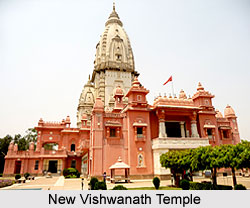 The new Vishwanath temple of Varanasi is located in the premises of the Banaras Hindu University. The temple was built by the famous industrialist family Birla family and hence it is also known as Birla temple. The temple was built as a replica of the old Vishwanath temple that was destroyed by the Mughal Emperor Aurangzeb. The New Vishwanath Temple is dedicated to Lord Shiva. The idol of the Lord has been installed in the inner sanctum of the temple. The temple is built with white marbles, and was planned by Madan Mohan Malviya, the founder of the Banaras Hindu University.
The new Vishwanath temple of Varanasi is located in the premises of the Banaras Hindu University. The temple was built by the famous industrialist family Birla family and hence it is also known as Birla temple. The temple was built as a replica of the old Vishwanath temple that was destroyed by the Mughal Emperor Aurangzeb. The New Vishwanath Temple is dedicated to Lord Shiva. The idol of the Lord has been installed in the inner sanctum of the temple. The temple is built with white marbles, and was planned by Madan Mohan Malviya, the founder of the Banaras Hindu University.
The New Vishwanath Temple has been made with exquisite marbles and looks stunning. The walls of the temple are adorned with the impressive sculptures of Hindu Gods and Goddesses. Verses from Hindu scriptures have also been inscribed on the walls. The most important characteristic of the new Vishwanath temple is that it is open to people from all castes and religions. The temple looks very charming and is thronged by people from different places.
This article is a stub. You can enrich by adding more information to it. Send your Write Up to content@indianetzone.com





















